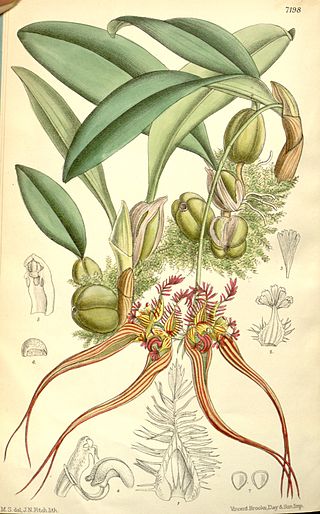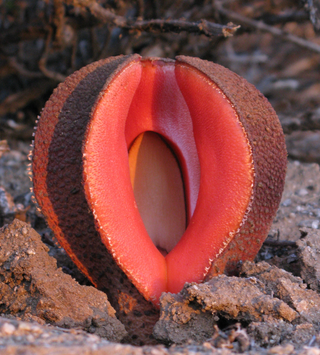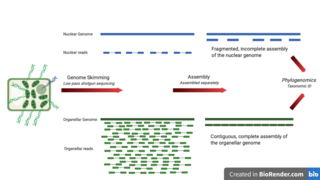
The Aristolochiaceae are a family, the birthwort family, of flowering plants with seven genera and about 400 known species belonging to the order Piperales. The type genus is Aristolochia L.

Pandanales, the pandans or screw-pines, is an order of flowering plants placed in the monocot clade in the Angiosperm Phylogeny Group and Angiosperm Phylogeny Web systems. Within the monocots Pandanales are grouped in the lilioid monocots where they are in a sister group relationship with the Dioscoreales. Historically the order has consisted of a number of different families in different systems but modern classification of the order is based primarily on molecular phylogenetics despite diverse morphology which previously placed many of the families in other groupings based on apparent similarity. Members of the order have a subtropical distribution and includes trees, shrubs, and vines as well as herbaceous plants. The order consists of 5 families, 36 genera and about 1,610 species.

Christen Christensen Raunkiær was a Danish botanist, who was a pioneer of plant ecology. He is mainly remembered for his scheme of plant strategies to survive an unfavourable season and his demonstration that the relative abundance of strategies in floras largely corresponded to the Earth's climatic zones. This scheme, the Raunkiær system, is still widely used today and may be seen as a precursor of modern plant strategy schemes, e.g. J. Philip Grime's CSR system.

Hydnoroideae is a subfamily of parasitic flowering plants in the order Piperales. Traditionally, and as recently as the APG III system it given family rank under the name Hydnoraceae. It is now submerged in the Aristolochiaceae. It contains two genera, Hydnora and Prosopanche:

Triuridaceae are a family of tropical and subtropical flowering plants, including nine genera with a total of approximately 55 known species. All members lack chlorophyll and are mycoheterotrophic. The heterotrophic lifestyle of these plants has resulted in a loss of xylem vessels and stomata, and a reduction of leaves to scales.

Petrosavia is a genus in the family Petrosaviaceae. It includes three mycoheterotrophic species from eastern and southeastern Asia.
- Petrosavia amamiensisHir.Takah., T.Yukawa & M.Maki
- Petrosavia sakuraii(Makino) J.J.Sm. ex Steenis - Japan, China, Vietnam, Myanmar, Sumatra
- Petrosavia sinii(K.Krause) Gagnep. in H.Lecomte - Guangxi Province of China
- Petrosavia stellarisBecc. - Borneo, Sulawesi, Sumatra, Peninsular Malaysia

Johannes Iversen was a Danish palaeoecologist and plant ecologist.

Tyge Wittrock Böcher was a Danish botanist, evolutionary biologist, plant ecologist and phytogeographer.

Botaniska Notiser was a Swedish scientific periodical concerning botany, issued in Lund, by Societate botanica Lundensi or [Lunds Botaniska Förening]. It was published from 1839 to 1980, when it fused with Botanisk Tidsskrift, Friesia and Norwegian Journal of Botany to form the Nordic Journal of Botany. In 2001, the journal reappeared as a regional journal for botany in south Sweden.

Thismia is a genus of myco-heterotrophic plants in family Burmanniaceae, first described as a genus in 1845. It is native to East and Southeast Asia, New Guinea, Australia, New Zealand, and the Americas.

Carl Emil Hansen Ostenfeld was a Danish systematic botanist. He graduated from the University of Copenhagen under professor Eugenius Warming. He was a keeper at the Botanical Museum 1900–1918, when he became professor of botany at the Royal Veterinary and Agricultural University. In 1923, by the early retirement of Raunkiær's, Ostenfeld became professor of botany at the University of Copenhagen and director of the Copenhagen Botanical Garden, both positions held until his death in 1931. He was a member of the Royal Danish Academy of Sciences and Letters and served on the board of directors of the Carlsberg Foundation.
Fredrik Christian Emil Børgesen was a Danish botanist and phycologist. He graduated in botany from the University of Copenhagen and was subsequently employed as an assistant at the Botanical Museum (1893–1900). His doctoral thesis dealt with the marine algae of the Faroe Islands (1904). Later, he became librarian at the Library of the Botanical Garden (1900–1935).
Henning Eiler (Ejler) Petersen was a Danish mycologist, botanist and marine biologist. He made a major contribution to unveiling the mysterious die-back of eel grass in Northern European waters in the early 20th century as a pathogen outbreak.

Lacandonia is a mycoheterotrophic plant that contains no chlorophyll and has the unusual characteristic of inverted positions of the male (androecium) and female (gynoecium) floral parts, something that had not been seen in any other plants, with the exceptions of Trithuria and on occasion the related Triuris brevistylis.

Bulbophyllum wendlandianum is a species of orchid in the genus Bulbophyllum.

Sciaphila is a genus of mycoheterotrophic plants in the family Triuridaceae. These plants receive nutrition from fungi and neighboring trees and have less need for photosynthesis. It is widespread in tropical and subtropical regions, found in Africa, China, Japan, the Indian Subcontinent, Southeast Asia, Latin America and on various islands Pacific Islands. The most noteworthy feature of the genus is the number of the various flower parts 99.9 percent of Monocots are trimerous, but Sciaphila spp. can have eight or even ten parts in a whorl.

Hydnora is a group of parasitic plants described as a genus in 1775. It is native to Africa, Madagascar, and the Arabian Peninsula. Hydnora pollinates through brood-site mimicry. This is a method of pollination in which the plant emits a smell that is attractive to insects, so that the plant can trap the insect and allow it to take pollen so that it can pollinate other Hydnora.

Hydnora visseri, the Visser's hydnora, is a subterranean holoparasitic plant, lacking leaves and roots, and is described from southwestern Namibia and northwestern South Africa and has the longest tepal lobes of all Hydnora species. The genus Hydnora is composed entirely of holoparasitic plants that attach to the root of their hosts and are restricted to Africa and southwestern Asia.

Genome skimming is a sequencing approach that uses low-pass, shallow sequencing of a genome, to generate fragments of DNA, known as genome skims. These genome skims contain information about the high-copy fraction of the genome. The high-copy fraction of the genome consists of the ribosomal DNA, plastid genome (plastome), mitochondrial genome (mitogenome), and nuclear repeats such as microsatellites and transposable elements. It employs high-throughput, next generation sequencing technology to generate these skims. Although these skims are merely 'the tip of the genomic iceberg', phylogenomic analysis of them can still provide insights on evolutionary history and biodiversity at a lower cost and larger scale than traditional methods. Due to the small amount of DNA required for genome skimming, its methodology can be applied in other fields other than genomics. Tasks like this include determining the traceability of products in the food industry, enforcing international regulations regarding biodiversity and biological resources, and forensics.
















